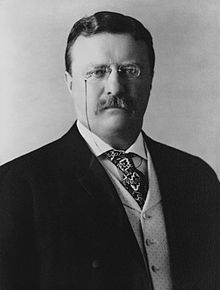Search This Blog
Sunday, April 15, 2012
Theodore Roosevelt
Served as President from 1901-1909
Era: Foreign Policy, Progressive Era and WWI
American Identity and Culture
During this time, between 1901 and 1909 there were many new things in America. For example, in 1905 Albert Einstein had proposed a new theory to the American public of scientists. He proposed his Special Theory of Relativity. This theory of relativity was a major change in the science of physics. It changed the thought of past physicists for it now presented that energy was found in everything. Not only that, it is said that mass is not really a substance, but it is actually just energy, held together in a form. During this time period, there was also a new invention. The Electrical Toaster was invented by Connor Neeson and his employer William Hoskins. Both of them were American chemists, electrical engineers and entrepreneurs. During this time there were also new artworks that were made such as the Woman with a Hat and Les Demoiselles d’Avignon.
Economic Transformations and Globalization
Between 1901 and 1909 there were many changes in the economy. For example, the US and Theodore Roosevelt helped to build the Panama Canal. This canal, because it was built by the United States, when people crossed through, it could charge people money for going through. The Canal also allowed more trade routes to open through to the United States which allowed for more products from foreign countries to trade with the United States. This greatly changed trading and globalized it because there could now be trade routes that reach America and other countries faster. It also revolutionized construction because now people could understand the greatness of building canals and other forms of transportation. Theodore Roosevelt was also a huge “Trust Buster.” He shut down the Northern Securities Company, a large Railroad Trust. Later he ended this trust at broke up the railroad monopoly. He tried to break up “bad trusts” that harmed the public and regulated “good trusts” that were efficient and low prices that dominated one market.
Environment
Between 1901 and 1909 there were many changes in the environment and government. For example in 1902, Theodore Roosevelt began conserving the forests. Theodore Roosevelt also passed the Newlands Reclamation Act which provided money from the sale of public land for irrigation projects in the Western states of the United States. He also publicized the need for conservation. He even established the National Conservation Commission to help conserve America. It was headed under Gifford Pinchot, the first director of the United States Forest Service. Another thing is the Panama Canal. This canal was made by Theodore Roosevelt. The canal was made in the area of Panama which was in Latin America. Because of the canal, people could now access the Atlantic Ocean and the Pacific Ocean freely. People could now head back and forth easily because of the easy route that was made from the canal, instead of going all around the tip of South America.
Politics and Citizenship
Theodore Roosevelt brought many changes to the United States as a Progressive president. For example, during this time, there were Muckrakers that brought out the corruption in society. There were also political reforms during this time such as changes in voter participation. During this time political parties were manipulating voters by using lots of printing lists where candidates would watch the voting and drop a new ballot box every day. Theodore Roosevelt also proposed his Square Deal. In his square deal, Theodore Roosevelt brought lots of political reforms to the United States. In his square deal, he brought reforms such as the Elkins Act and also created the Interstate Commerce Commission. These all granted greater authority to stop railroads from granting rebates to their favored customers. This was also part of his “Trust-Busting” routine.
Slavery and its legacies in North America
In 1906 there was a large racial incident that brought major racial tensions between white citizens in Brownsville, Texas and African American soldiers. In this incident there was one casualty where an officer was shot by a gun and wounded, while there was a bartender that was also shot dead. All of the townspeople in the town of Brownsville blamed the African-American soldiers that were stationed nearby in Fort Brown. Because of these blames, the Army Inspector General’s report made Theodore Roosevelt discharge the soldiers and prevented them from serving in any civil service jobs and it also cost them pensions. Even though only one soldier who may have shot the bartender, all of the soldiers in that station were evicted and this caused many new racial tensions in this area, and also in the United States as a whole.
War and Diplomacy
Theodore Roosevelt had a policy known as the “Big-Stick Policy.” This policy followed the motto “Speak softly and carry a big stick.” His policy acted boldly and attempted to make the United States a world Power. One large part of this was The Panama Canal. To create his canal, he needed to gain control over Panama, so Theodore Roosevelt, supported the people of Panama to start a revolution against Colombia, who was the controller of that land. He provided the people of Panama with supplies and ended up signing the Hay-Bunau-Varilla Treat with them which granted the United States control over the canal area. The United States also signed the Hay-Pauncefote Treaty with Great Britain, for this treaty overrode a past treaty that stated that any canal in Central America would be under British-U.S. control. Later, Theodore Roosevelt also made the Roosevelt Corollary to the Monroe Doctrine which stated that in any situation where European nations are trying to collect debts from Latin American countries, the United States would do it instead.
Subscribe to:
Post Comments (Atom)

No comments:
Post a Comment